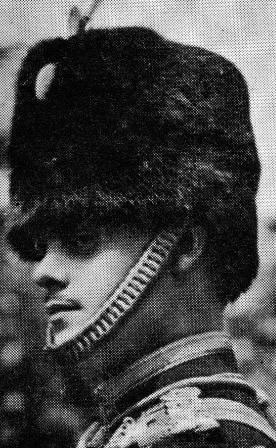Remembering the Fallen: On the 24th of September 1914, Lieutenant Colin Barclay Leechman, the 3rd (The King’s Own) Hussars, was killed near Ailles in France.

Born in Ceylon, where his father was a merchant and agent, he was educated at Rugby School and Exeter College, Oxford, where he joined the Officer Training Corps. In 1911 he was gazetted to the 3rd (The King’s Own) Hussars, being promoted to Lieutenant a year later.
His regiment landed at Rouen on the 17 of August. By the end of the month, they had their first fatality in an encounter with German cavalry and cyclists, and two weeks later they saw action in the battle for the Chemin des Dames ridge.
The following day in the firing line they endured a barrage of nine-inch shells from a German Howitzer battery, on which it was reported “The noise of the explosions was terrific, but the damage was nil.” They began to dig, forming what was described as “the embryo of the trench system” that would develop along the Western Front by the end of 1914.
On the morning of the 23rd of September Lieutenant Leechman and his men marched to Paissy, where they were concealed in caves and ordered to remain until relieved by the 2nd Cavalry Brigade.
The next day Lieutenant Leechman was reported missing; it was hoped that he had been captured rather than killed, but an official enquiry to Berlin received the response that he was not a prisoner.
In March of 1915, the Commanding Officer of the regiment ordered a court of inquiry to be held into Lieutenant Leechman’s fate. There was only one witness, who said: “I was on a special patrol commanded by Lieutenant Leechman…we were keeping communication between a battalion of Zouaves and the West Surrey Regiment and Lieutenant Leechman was all day at intervals going up on foot to the firing line, generally to the French line. After dark, he stayed with the sentry just above the horses.
At 1 am I was on sentry and Lieutenant Leechman went towards the Zouaves firing line on foot…I never saw him again.” Based on this account the court determined that “There is no evidence to reasonably suppose that Lieutenant Leechman is dead”. The Casualties Section at the War Office would not accept the report as conclusive proof of death, and the Lieutenant’s family began to make enquiries with members of his regiment, the Red Cross, and business acquaintances with pre-war links in Germany.
One such acquaintance wrote to Dr Max Vollert, the Principal of the University of Jena, who replied that he would do his best to help. He wrote to every officer that had served in the Paissy area, and sent letters to the War Office in Berlin and the prisoner-of-war camps.
In April he heard from a German officer that one of his men, Corporal Richter, had come across the body of Lieutenant Leechman near Ailles, several miles from where he was last seen. Lieutenant Leechman’s father informed the War Office but an official “grumbled” that the evidence had been arrived at “in rather a round-about way” and that an official report would be required from the army in France. On the 18th of April, the decision was made to declare the Lieutenant “unofficially dead”, thereby allowing his name to be erased from the army list and for probate to begin.
Two months later his death was publicly recognised when he was mentioned at a memorial service in Rugby School’s chapel.
Corporal Richter had found his body on the 26th of September, which was when the French had re-taken that piece of ground, so it was assumed the French would bury him.
It is not known why the identification papers, once they left the corporal’s hands, were not passed on as would have been expected.
In 1920 a labour company searching for remains discovered a cross marked “Cavalry Unknown British Officer” but after much digging no remains were found – although the cross could have not been for any other cavalry officer, which meant his death could finally be confirmed.
Lieutenant Leechman is commemorated on the La Férté-sous-Jouarre Memorial to the Missing; he was 25 years old.


